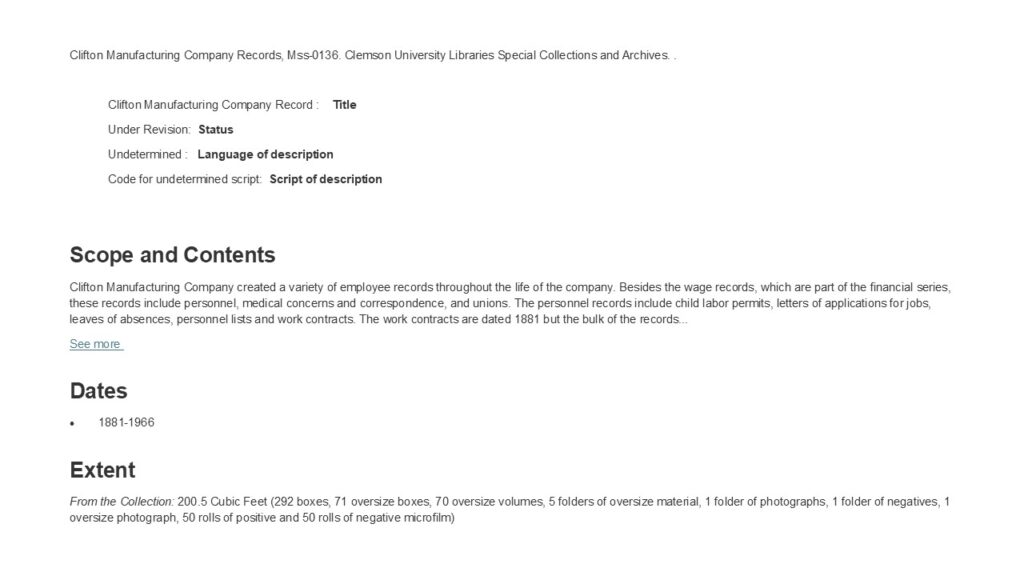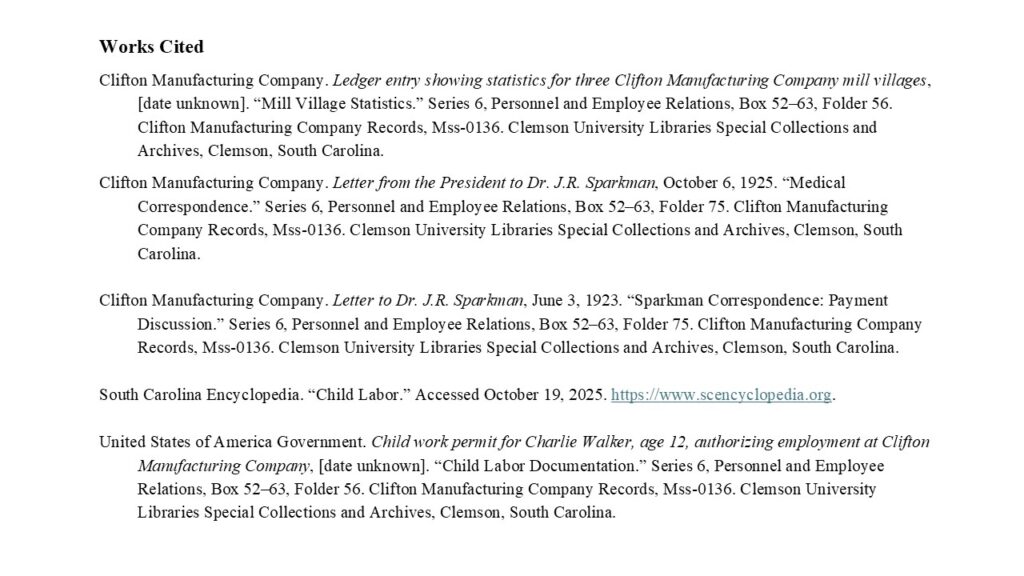Insights from Archival Research
Child labor shaped the early textile industry in South Carolina, leaving behind stories that are hard to imagine today. To uncover these realities, researchers turn to archives—repositories of authentic voices and records that bring history to life.
One collection that stood out to me during my research was the Clifton Manufacturing Company Records (Mss-0136) at Clemson University Libraries Special Collections and Archives. Why this collection? Because it contains work permits for children, a rare and powerful window into the lives of young mill workers. Most permits are for 14-year-olds, but some, like the one for Charlie Walker at age 12, reveal how families and companies navigated the law—and sometimes bent it—to keep mills running.
The Law and the Loopholes
By 1915, South Carolina passed a law requiring a signed statement from a parent or guardian affirming that a child was of legal employment age. This was meant to protect children, but in practice, it opened the door to abuse by desperate families seeking extra income.
Domestic and agricultural workers were exempt. Children over twelve with a widowed mother or disabled father were excused from age limits. Orphans could be employed at any age—one child reportedly began working at just five years old (South Carolina Encyclopedia).
This context makes the child work permit for Charlie Walker, age 12, especially striking. Found in Series 6, Box 52–63, Folder 56, this U.S. government-issued permit authorized his employment at Clifton Manufacturing Company. It’s a tangible reminder of how legal frameworks were stretched to accommodate economic realities. For a future research project, this permit could serve as a focal point for studying enforcement gaps and family survival strategies during the Progressive Era.
Health and Responsibility
Child labor wasn’t the only challenge in mill life—health care loomed large. Among the Clifton records are letters that reveal how medical issues were handled.
One letter, dated October 6, 1925, from the company president to Dr. J.R. Sparkman, discusses medical concerns for employees. Another, from June 3, 1923, addresses payment for medical services. Both are housed in Series 6, Box 52–63, Folder 75.
These letters suggest a complex relationship between mill owners and healthcare providers. They raise questions about corporate responsibility: Were mills genuinely concerned about worker welfare, or were these negotiations driven by economic necessity? A future research project could explore industrial health care practices and their role in shaping labor relations.
Life Beyond the Loom
Numbers tell their own story. A ledger entry showing statistics for three mill villages, also in Series 6, Box 52–63, Folder 56, offers demographic and housing data. This single document could underpin a study of living conditions in mill communities—how family size, housing quality, and village layout influenced labor patterns and social life.
Combined with the work permits and correspondence, this ledger helps paint a fuller picture: mills weren’t just workplaces; they were ecosystems where economic, social, and health factors intertwined.
Navigating the Collection
The Clifton Manufacturing collection is not fully curated. While the finding aid provides basic descriptions of series and folders, detailed item-level descriptions are missing. Researchers must rely on scope and content notes and series descriptions, then dig into boxes to uncover treasures like these permits and letters.

Why These Sources Matter
Together, these documents provide a multidimensional view of mill life—legal, medical, economic, and social. They are not just relics; they are reference points for future scholarship on labor history, public health, and industrialization in the South.
Conclusion
Archival research transforms abstract history into tangible narratives. By engaging with primary sources like those in the Clifton Manufacturing Company Records, we uncover the lived realities behind child labor statistics and legislation. These materials invite us to ask deeper questions—and perhaps, to tell stories that have long been silent.

